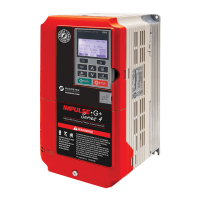IMPULSE
®
•G+ & VG+ Series 4 Technical Manual
November 2020
Page 211
8. If none of the above steps has identified a valid problem(s), only then should the speed deviation detection
levels be adjusted.
NOTE: The reaction time necessary to stop a load is limited to the lift of the hoist and the response time of the hoist
brakes. It is desirable to have as fast a fault reaction time as possible without causing nuisance trips.)
9. Increase Encoder Excessive Speed Deviation Level to no more than 30 (F01-27).
10. After the corrective action has been taken and the fault no longer occurs then the load float time,
C08-10, can be set back to its initial value.
6.2.2 Fault Code: PGO-X-S/PGO-X-H–Pulse Generator Signal Fault
6.2.2.1 Definition
The pulse generator signal missing fault indicates that the VFD has detected a problem with encoder feedback.
This fault will typically occur if the VFD doesn’t receive any encoder feedback pulses while it is commanded to run
or encoder wiring has a discontinuity.
NOTE: The “X” in PGO-X-S and PGO-X-H depicts either a “1” if the PG-X3 is seated in connector CN5-C, or a “2”
if the PG-X3 is seated in connector CN5-B.
6.2.2.2 Corrective Action
1. Do NOT continue to operate the hoist in the event of a PGO-X-H fault or repeated PGO-X-S faults.
NOTE: Continued attempts to operate the hoist with PGO faults occurring can result in loss of control of the load
under certain circumstances.
2. As a precaution, the load float time, parameter C08-10, should be set to zero until the source of the PGO Fault
has been determined and corrected. Disable PGO hardware detection with F01-06 or F01-08.
3. Check the alignment of the encoder pulse wheel with the sensor head, the encoder shaft coupling (depending
on the type of encoder used), or check for a failed encoder sensor head. If one of these conditions exists the
VFD will get erratic pulse signals or no signal at all causing a speed deviation fault or PGO fault. Repairs to the
encoder wheel or shaft coupling should be made immediately before attempting to operate the hoist again.
4. If the encoder appears to have no mechanical problems, the encoder cable should be checked for damage and
replaced if a problem is found.
• Each of the encoder wires should be check for continuity.
• The wires should be checked for shorts between any two wires.
• The wires should be checked for shorts to the shield or ground.
• Visually inspect the cable for damage that may be causing intermittent problems.
5. If the encoder feedback system checks out, then check for physical obstruction to motor rotation such as brake
failing to open.
6. After corrective action has been taken and the fault no longer occurs then the load float time, C08-10, can be
set back to initial value.

